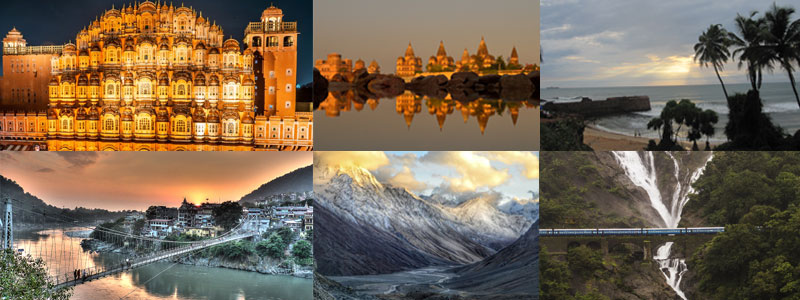With without and in spite of COVID-19, some of the key tourist attractions of the world are gradually opening up to welcome visitors. This has come as a fresh breath of relief for the travel and tourism industry that has been cramped to a standstill due to the global lockdown. Despite the travel restrictions imposed by the majority of the nations of the world “a host of tourist destinations around the world are beginning to ease their lockdown and border restrictions” [1]. Setting the trend into action, Croatia was the first country in the world to open up for domestic tourists, while China and Vietnam were the first in Asia to follow suit.
As per reliable sources, the first 10 countries across the globe to have resumed their tourist activities are “Greece, Vietnam, Denmark, China, Croatia, Egypt, Bulgaria, Portugal, Netherlands and Switzerland” [1]. In this manner, while “Europe, Oceania & Africa are leading the way… North and South America” are yet to open their gates for tourism. The world’s travel and tourism industry is thus recovering to action sooner than expected and even the countries like Italy and Germany that encountered major setbacks due to the pandemic have now opened their doors to domestic tourists.
Spurred by the preceding initiatives, 30+ countries across the globe have identified safe countries to entertain international travel and have accordingly opened their borders to international travellers from select nationalities. Some of the safe countries that are thus identified are “Japan, Greece and Hong Kong” that “have the lowest cases per million” [1]. In this fashion, like a trial run before the main action, “50% of countries worldwide” [1] have commenced domestic travel and tourism before hitting the international milestone.

Similarly, outdoor tourism and related activities are first promoted before establishing the norms that would confirm the safety of indoor tourism-oriented activities. Outdoor tourism offers greater scope for maintaining social distance and hence research discloses that “70% of nature camps, hiking trails, adventure sports, national parks and beaches are reopened around the world” [1]. Thus, outdoor activities like “hiking, camping, biking and trekking have become increasingly popular in the post-COVID era” [2], while road trips in RVs, fishing, cycling, and sailing are among the other favourites.
To ensure that hygiene norms are effectively observed at outdoor attractions spots like nature parks & wildlife reserves have reduced the visitor capacity. In addition, to avoiding queue in front of counters and avoid unexpected rush of visitors, more than 45% of tourist attractions around the world have mandated the purchase of online tickets. Notable in this context of entertaining contactless tourism is the rise of Virtual Tourism in being accepted, offered, and welcomed as a valid form of leisure tourism.
Despite these emerging travel and tourism trends, global surveys reveal that “travellers refrain from visiting international destinations” [2] thereby increasing the popularity and demand of domestic tourism. Thus countries with a lot of natural and indigenous attractions will find a boom in domestic tourism owing to the increased rate of local visitors who are driven to plan more trips within the border of their own countries. The countries that are expected to benefit the most from this trend among tourists are “Germany, U.K and China, while the countries like the U.S., Spain and Turkey which do not have a strong international travel base will see a decline in tourism spend within their borders” [2].

In India, many states have lifted travel restrictions to revive the economy. The governments of the states that have thus lifted the curb have laid down tactical SOPs and guidelines for travellers to follow. Listed below are the notable few states that are open for tourism.
- Madhya Pradesh: Immediately reacting to the announcement of Unlock 2.0, the state government of Madhya Pradesh launched a campaign named ‘Intezaar Aapka’ [3], which has re-opened major tourist attractions like national parks and monuments along with a number of state-run hotels and resorts. The state government mandates the visitors to strictly adhere to the rules and guidelines for travellers issued by Ministry of Tourism, Government of India.
- Himachal Pradesh: The majestic mountains, lush green valleys, and the gushing rivers of the land are open for tourists now. The state mandates that the travellers should “register themselves on covid19epass.hp.gov 48 hours before their visit; carry a COVID-19 negative report issued not earlier than 72 hours” [3], and should have installed the Aarogya Setu app in their mobile phones.
- Uttarakhand: The Chota Char Dham formed by the Hindu shrines at the Gangotri and Yamunotri along with with Kedarnath and Badrinath is now reopened for residents of Uttarakhand. The state has also opened other major attractions like Mussoorie, Haridwar, Rishikesh, Jim Corbett, and Nainital for tourist activities. However, the state restricts the entry of tourists to the shrines and other attractions from 10 PM to 7 AM. The tourists should carry a COVID-19 negative test result issued within 72 hours. [3]
- Goa: Following the Unlock 2.0, the major attractions of Goa like the Calangute Beach, Basilica of Bom Jesus Church, Chapora Fort, Baga Beach, Dudhsagar Falls and Anjuna Beach are now open for the access of tourists. The state mandates the visitors to abide by its rules and guidelines like staying only in pre-booked state-approved hotels, and producing a COVID-19 negative report from the last 48 hours whenever asked.
- Rajasthan: The royal edifices, parks, temples, and other man-made marvels of Jaipur, Jodhpur, Jaisalmer, Mount Abu, Udaipur, Pushkar and Ranthambhore in Rajasthan are now opened for the tourists. The state government of Rajasthan requires the visitors to follow “COVID-19 safety protocols like using sanitizers, wearing a mask and maintaining social distancing at all times” [3]. Further, the tourists are directed to cooperate to the mandatory screening at entry points.
As the world gradually recovers from the adversities of the pandemic, gaining quick momentum, which is a sign that the sudden peaking in the domestic tourism would be eventually equalized by the active resumption of international travel. However, as per popular opinion, that domestic visitors for attractions within countries will see a notable rise in numbers compared to the pre-pandemic era. This will lead to the development of existing domestic destinations and the discovery of destinations that were previously unknown to cater to the travellers searching for local experiences [2].
As evident, protection from being exposed to the coronavirus is the major priority among today’s travellers in all their expectations from any tourism or related activity. The countries of the world are seen to have woken up to this fact and have begun to address the need in a relatively quicker fashion, yet with utmost care to instil confidence in the traveller. Valid global surveys reveal that such travel and tourism trends adopted by domestic and international players are successful in reviving the travel and tourism sector, especially on a domestic scale. Thus, the ardent travellers of the world are looking up to the governments of the world and the service providers with hope to resume their way of life uninterrupted as ever before.
References:
- https://blog.headout.com/post-covid-travel-reopening-trends/
- https://blog.headout.com/emerging-travel-trends-post-covid/
- https://www.fabhotels.com/blog/places-in-india-are-now-open-for-tourism/